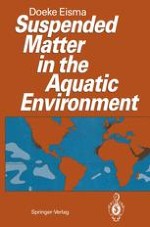1993 | OriginalPaper | Buchkapitel
Transport of Suspended Matter
verfasst von : Professor Dr. Doeke Eisma
Erschienen in: Suspended Matter in the Aquatic Environment
Verlag: Springer Berlin Heidelberg
Enthalten in: Professional Book Archive
Aktivieren Sie unsere intelligente Suche, um passende Fachinhalte oder Patente zu finden.
Wählen Sie Textabschnitte aus um mit Künstlicher Intelligenz passenden Patente zu finden. powered by
Markieren Sie Textabschnitte, um KI-gestützt weitere passende Inhalte zu finden. powered by
Transport of suspended matter takes place through the water column, as opposed to bottom transport. Sand may partly move in an intermediate mode by jumping over the bottom, which is called saltation. Suspended matter is usually fine-grained/low density material while the bed load is usually coarsergrained/high density material. There is, however, no sharp distinction between transport in suspension and bottom transport: also sand grains that are normally transported over the bottom can be transported in suspension in large quantities where currents and turbulence are sufficiently high, as is the case in rivers, in the surf along beaches, and on sandy shelves during storms. Transport in suspension is primarily related to the turbulence in the water but the conditions under which the turbulence is generated strongly influence the transport pattern. In this chapter, unidirectional or quasi-unidirectional transport as occurs in rivers and streams and suspension by surface waves will be discussed in Sections 5.2 and 5.4, preceded by a short general introduction on turbulence (in Sect. 5.1). Transport takes place between two moments: the initiation of particle motion by scour (erosion, resuspension), and the settling of particles where the turbulence is too weak to keep them in suspension. These will be discussed in Sections 5.3, 5.5 and 5.6 followed by brief discussions of suspended matter transport in stratified waters (Sect. 5.7) and of autosuspension of suspended matter in downward flow (Sect. 5.8).
